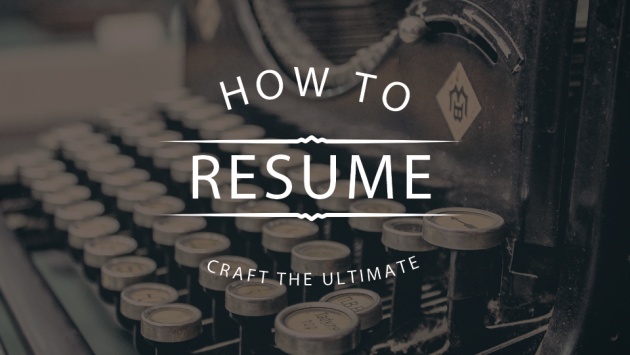If you’re trying to nail your dream job, or just looking for some part-time work, having the perfect resume is vital. You need to stand out from the crowd on a piece of paper, and that is as difficult as it sounds. But it’s not all doom and gloom.

I have prepared and tailored resumes for several clients, and I have observed common mistakes made throughout. Though these may seem minor or superficial to you, they are the difference between an interview and a rejection. Here are some things you need to consider to make yours the perfect resume:
1. Standardise
Your resume should run standardised throughout: the formatting, the font, the colours, everything. Think about the opinion this gives an employer. If your resume is messy, that is the first impression they will have of you – sloppy, disorganised, and unmotivated. Depending on the job you are going for, either use simple spacing, and a clean readable font, or grab a template for a more creative approach. If you really want to stand out, go all out and make a totally unique template, but make sure it is standardised.
2. Be transparent (social networks, phone number, address)
The perfect resume is all about you, and with the 21st century being a time of transparency (for both companies and individuals), make sure your resume reflects that you have nothing to hide. I don’t suggest adding your Twitter handle or Facebook profile to it (unless you’re going for a digital job, such as a social media role) but include your LinkedIn profile, address, and contact numbers. Employers like to know that they have the ability to contact you, or find out more information about you, from cues given within your resume. It also establishes a subtle trust between both parties.
3. Print your Pitch
If you don’t already have an elevator pitch I suggest you craft one. For those unfamiliar with the term, an elevator pitch is a quick 30-second summary of yourself, your ambitions, and your skills; you’re meant to be able to reel it off to a potential employer in a brief introduction. Not only does it help your employer, but it helps you understand yourself and what you want to be able to achieve. 30-seconds (or let’s say no more than 150 words) does not give you a lot of room for content, and forces you to prioritise your goals. Once you’ve crafted your self-summary, paste it into the top of your resume. Most employers don’t want to read your life story, but if they can understand you in 3 lines, you have a better chance at securing the job.
4. Tailor to your Market
This is probably the most important point on this list. For your resume to be perfect you have to understand who your employer is. The resume you send to Apple is not going to be the same as the one you send to Goldman Sachs. Do some research and understand your employer’s ethos, company culture, and desires. If you’re applying to a job posted, make sure you read the job description and find where you can highlight that you have the requirements – your experience, key skills, achievements, or education. If your resume is tailored to suit the employer, you have a greater chance even if you do not meet all the requirements. What’s better, a highly-experienced employee people don’t get on with, or a less-experienced employee who gets on with everyone?
5. Get your things in order
The order of your resume is also vitally important. Personally, I would say there are 5 main sections to consider: Profile, Experience, Interests, Qualifications & Achievements, Key Skills. They are listed in the order I would use them, and here’s why:
Your profile is your elevator pitch. It’s the introduction/synopsis of your resume, and gives the reader a quick glimpse of who you are. Experience is next as they will want to see your experience. I place Interests before Qualifications because they give an insight into what you do outside of working hours, and a greater insight into your personality. Not only that, but if you have some interesting things you do on the side, it is a great way of showing intrinsic motivation. The only suggestion would be that do not include anything that seems very time- or attention-consuming: employers will want you to be dedicated to your work and will not like to see your attention being shared too greatly. Keep Qualifications brief, it’s just a formality to see what education you’ve undergone but does not necessarily play a huge part in the decision-making process (again, dependent on the type of job you are applying for). Key Skills again offers insight into what you think you are good at, displaying confidence and acquired skills. It is a nice way to funnel out at the end of a resume, a smooth ending.
6. Quality, not Quantity
Don’t write your life story. Only include experience and interests which you think are relevant to the job you are applying for. If you’ve worked as an Intern for a competitor, that is more relevant than the fact that you did weekend shifts at Wall-mart. You get the gist, but this depends on how much experience you have to work with.
7. Go Backwards in Time
Write your experience in reverse chronological order (most recent first). Your employer is more concerned with the job you just had then something you did 5, 10 years ago. However, relating to point 1, do this for all forms of time-scale throughout your resume. Consistency is key.
8. Unfinished Business
Do not omit any current or on-going work and projects. Your employers want to know what you are currently up to, to gauge whether or not you are ready for the job on offer. They will understand that in having a job you have to give notice periods and these do not often change the opinion of an employer. They would much rather know than not (point 2 – transparency).
9. Add some flare
Do not write your resume like it’s a status report. The common misconception is that a resume is there just so the employer knows what you’ve done, a historical document of your professional life. No! This is not the case. Your resume is designed to sell you. It’s a personal advert. Add some flare, some personality. You’re selling yourself, so sell YOU, not your experience.
10. Include experience, aims, and achievements
So you’ve got some personality and your experience is listed. However, most people forget to include their aims, goals, and ambitions on their resumes. A company does not only want to know if you’re right for them, but if the company is right for you. They want to be sure that they can give you what you desire also, so that you can both grow alongside each other. This is more important than you think; it may be what you consider your ideal job, but if you feel like you are not learning or developing at all, you will slowly tire and get bored.
Extra Tip for Paper Resumes: Use heavy, quality paper. Psychological research has shown that resumes printed on heavier, good quality paper are seen as more important and better qualified than those on flimsy paper. If you really want the job, you’ve got to pull out all the stops.
I understand that this has been a somewhat lengthy article, but it was my intention to make it thorough the reasonings behind each section so as to give you more insight and ideas in formatting and writing your own resumes. I wish you all the best of luck with job-hunting, and hope your perfect resume allows you to get the perfect job.
Source:
http://www.lifehack.org/articles/work/10-tips-how-craft-perfect-resume.html



